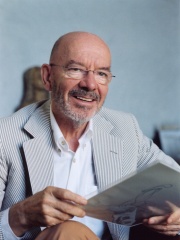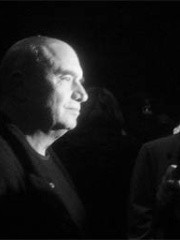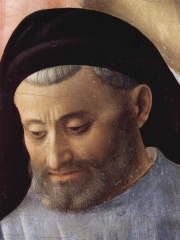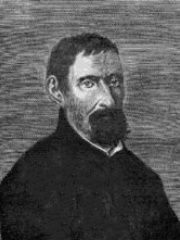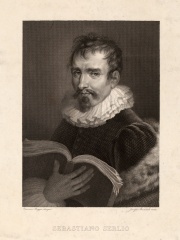
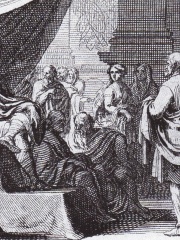
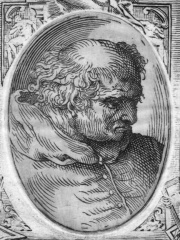
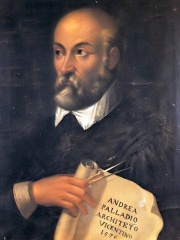

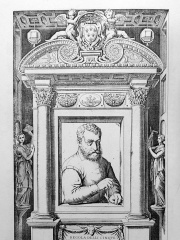
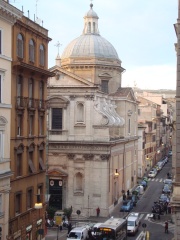
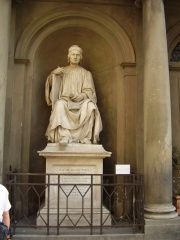
The Most Famous
ARCHITECTS from Italy
This page contains a list of the greatest Italian Architects. The pantheon dataset contains 518 Architects, 65 of which were born in Italy. This makes Italy the birth place of the most number of Architects.
Top 10
The following people are considered by Pantheon to be the top 10 most legendary Italian Architects of all time. This list of famous Italian Architects is sorted by HPI (Historical Popularity Index), a metric that aggregates information on a biography's online popularity. Visit the rankings page to view the entire list of Italian Architects.

1. Gian Lorenzo Bernini (1598 - 1680)
With an HPI of 83.54, Gian Lorenzo Bernini is the most famous Italian Architect. His biography has been translated into 76 different languages on wikipedia.
Gian Lorenzo (or Gianlorenzo) Bernini (UK: , US: ; Italian: [ˈdʒan loˈrɛntso berˈniːni]; Italian Giovanni Lorenzo; 7 December 1598 – 28 November 1680) was an Italian sculptor, architect, painter and city planner. Bernini's creative abilities and mastery in a range of artistic arenas define him as a uomo universale or Renaissance man. While a major figure in the world of architecture, he was more prominently the leading sculptor of his age, credited with creating the Baroque style of sculpture. As one scholar has commented, "What Shakespeare is to drama, Bernini may be to sculpture: the first pan-European sculptor whose name is instantaneously identifiable with a particular manner and vision, and whose influence was inordinately powerful ..." In addition, he was a painter (mostly small canvases in oil) and a man of the theatre: he wrote, directed and acted in plays (mostly Carnival satires), for which he designed stage sets and theatrical machinery. He produced designs as well for a wide variety of decorative art objects including lamps, tables, mirrors, and even coaches. As an architect and city planner, he designed secular buildings, churches, chapels, and public squares, as well as massive works combining both architecture and sculpture, especially elaborate public fountains and funerary monuments and a whole series of temporary structures (in stucco and wood) for funerals and festivals. His broad technical versatility, boundless compositional inventiveness and sheer skill in manipulating marble ensured that he would be considered a worthy successor of Michelangelo, far outshining other sculptors of his generation. His talent extended beyond the confines of sculpture to a consideration of the setting in which it would be situated; his ability to synthesize sculpture, painting, and architecture into a coherent conceptual and visual whole has been termed by the late art historian Irving Lavin the "unity of the visual arts".

2. Vitruvius (75 BC - 15 BC)
With an HPI of 82.46, Vitruvius is the 2nd most famous Italian Architect. His biography has been translated into 78 different languages.
Vitruvius ( vi-TROO-vee-əs; Latin: [wɪˈtruːwi.ʊs]; c. 80–70 BC – after c. 15 BC) was a Roman architect and engineer during the 1st century BC, known for his multi-volume work titled De architectura. As the only treatise on architecture to survive from antiquity, it has been regarded since the Renaissance as the first book on architectural theory, as well as a major source on the canon of classical architecture. It is not clear to what extent his contemporaries regarded his book as original or important. He states that all buildings should have three attributes: firmitas, utilitas, and venustas ("strength", "utility", and "beauty"), principles reflected in much Ancient Roman architecture. His discussion of perfect proportion in architecture and the human body led to the famous Renaissance drawing of the Vitruvian Man by Leonardo da Vinci. Little is known about Vitruvius' life, but by his own description he served as an artilleryman, the third class of arms in the Roman military offices. He probably served as a senior officer of artillery in charge of doctores ballistarum (artillery experts) and libratores who actually operated the machines. As an army engineer he specialized in the construction of ballista and scorpio artillery war machines for sieges. It is possible that Vitruvius served with Julius Caesar's chief engineer Lucius Cornelius Balbus. Vitruvius' De architectura was well-known and widely copied in the Middle Ages and survives in many dozens of manuscripts, though in 1414 it was "rediscovered" by the Florentine humanist Poggio Bracciolini in the library of Saint Gall Abbey. Leon Battista Alberti published it in his seminal treatise on architecture, De re aedificatoria (c. 1450). The first known Latin printed edition was by Fra Giovanni Sulpitius in Rome in 1486. Translations followed in Italian, French, English, German, Spanish, and several other languages. Though any original illustrations have been lost, the first illustrated edition was published in Venice in 1511 by Fra Giovanni Giocondo, with woodcut illustrations based on descriptions in the text. Bramante, Michelangelo, Palladio, Vignola and earlier architects are known to have studied the work of Vitruvius, and consequently it has had a significant impact on the architecture of many European countries.

3. Donato Bramante (1443 - 1514)
With an HPI of 81.20, Donato Bramante is the 3rd most famous Italian Architect. His biography has been translated into 70 different languages.
Donato Bramante (1444 – 11 April 1514), born as Donato di Pascuccio d'Antonio and also known as Bramante Lazzari, was an Italian architect and painter. He introduced Renaissance architecture to Milan and the High Renaissance style to Rome, where his plan for St. Peter's Basilica formed the basis of the design executed by Michelangelo. His Tempietto (San Pietro in Montorio) marked the beginning of the High Renaissance in Rome (1502) when Pope Julius II appointed him to build a sanctuary over the spot where Peter was martyred.

4. Andrea Palladio (1508 - 1580)
With an HPI of 80.16, Andrea Palladio is the 4th most famous Italian Architect. His biography has been translated into 74 different languages.
Andrea Palladio ( pə-LAH-dee-oh; Italian: [anˈdrɛːa palˈlaːdjo]; Venetian: Andrea Paładio; 30 November 1508 – 19 August 1580) was an Italian Renaissance architect active in the Venetian Republic. Palladio, influenced by Roman and Greek architecture, primarily Vitruvius, is widely considered to be one of the most influential individuals in the history of architecture. While he designed churches and palaces, he was best known for country houses and villas. His teachings, summarized in the architectural treatise, The Four Books of Architecture, gained him wide recognition. The city of Vicenza, with its 23 buildings designed by Palladio, and his 24 villas in the Veneto are listed by UNESCO as part of a World Heritage Site named City of Vicenza and the Palladian Villas of the Veneto. The churches of Palladio are to be found within the "Venice and its Lagoon" UNESCO World Heritage Site.

5. Leon Battista Alberti (1404 - 1472)
With an HPI of 79.83, Leon Battista Alberti is the 5th most famous Italian Architect. His biography has been translated into 62 different languages.
Leon Battista Alberti (Italian: [leombatˈtista alˈbɛɾti]; 14 February 1404 – 25 April 1472) was an Italian Renaissance humanist author, artist, architect, poet, priest, linguist, philosopher, and cryptographer; he epitomised the nature of those identified now as polymaths. He is considered the founder of European cryptography, a claim he shares with Johannes Trithemius. He is often considered primarily an architect. However, according to James Beck, "to single out one of Leon Battista's 'fields' over others as somehow functionally independent and self-sufficient is of no help at all to any effort to characterize Alberti's extensive explorations in the fine arts". Although Alberti is known mostly as an artist, he was also a mathematician and made significant contributions to that field. Among the most famous buildings he designed are the churches of San Sebastiano (1460) and Sant'Andrea (1472), both in Mantua. Alberti's life was told in Giorgio Vasari's Lives of the Most Excellent Painters, Sculptors, and Architects.

6. Renzo Piano (b. 1937)
With an HPI of 74.89, Renzo Piano is the 6th most famous Italian Architect. His biography has been translated into 66 different languages.
Renzo Piano (Italian: [ˈrɛntso ˈpjaːno]; born 14 September 1937) is an Italian architect. His notable works include the Centre Georges Pompidou in Paris (with Richard Rogers, 1977), The Shard in London (2012), Kansai International Airport in Osaka (1994), the Whitney Museum of American Art in New York City (2015), Istanbul Museum of Modern Art in Istanbul (2022), Stavros Niarchos Foundation Cultural Center in Athens (2016) and The New York Times Building in New York City (2007). He was awarded the Pritzker Architecture Prize in 1998. Piano has served as a senator for life in the Italian Senate since 2013.

7. Giacomo Barozzi da Vignola (1507 - 1573)
With an HPI of 72.02, Giacomo Barozzi da Vignola is the 7th most famous Italian Architect. His biography has been translated into 40 different languages.
Giacomo Barozzi da Vignola (UK: vin-YOH-lə, US: veen-, Italian: [ˈdʒaːkomo baˈrɔttsi da (v)viɲˈɲɔːla]; 1 October 1507 – 7 July 1573), often simply called Vignola, was one of the great Italian architects of 16th century Mannerism. His two great masterpieces are the Villa Farnese at Caprarola and the Jesuits' Church of the Gesù in Rome. The three architects who spread the Italian Renaissance style throughout Western Europe are Vignola, Serlio and Palladio. He is often considered the most important architect in Rome in the Mannerist era.

8. Giacomo della Porta (1533 - 1602)
With an HPI of 71.94, Giacomo della Porta is the 8th most famous Italian Architect. His biography has been translated into 36 different languages.
Giacomo della Porta (1533–1602) was an Italian architect and sculptor. Most likely born in Genoa or Porlezza, Italy, his work was inspired by famous Renaissance artists such as Michelangelo and Giacomo Barozzi da Vignola. He started in his career as a sculptor in his late 20s, and later transitioned into a more architectural focus. Della Porta's work on the Oratory of Santissimo Crocifisso marked the beginning of his architectural career in Rome. In 1564, he was elected as Architetto del Popolo Romano (Architect of the Roman People) and under this title he completed some of his most notable commissions, both public and private. Throughout his career, Della Porta had a tendency to carry out projects begun by other architects, or make particular additions to a project of another architect, as opposed to completing a project of his own from start to finish.

9. Arnolfo di Cambio (1240 - 1302)
With an HPI of 71.60, Arnolfo di Cambio is the 9th most famous Italian Architect. His biography has been translated into 41 different languages.
Arnolfo di Cambio (c. 1240 – 1300/1310) was an Italian architect and sculptor of the Duecento, who began as a lead assistant to Nicola Pisano. He is documented as being capomaestro or Head of Works for Florence Cathedral in 1300, and designed the sixth city wall around Florence (1284–1333). By the end of his career he evidently had one or more workshops of some size, producing work with considerable stylistic variation, and distinguishing his personal hand can be difficult.
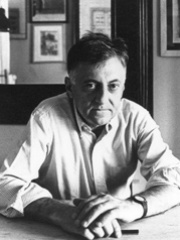
10. Aldo Rossi (1931 - 1997)
With an HPI of 71.17, Aldo Rossi is the 10th most famous Italian Architect. His biography has been translated into 42 different languages.
Aldo Rossi (3 May 1931 – 4 September 1997) was an Italian architect and designer who achieved international recognition in four distinct areas: architectural theory, drawing and design and also product design. He was one of the leading proponents of the postmodern movement. He was the first Italian to receive the Pritzker Prize for architecture.
People
Pantheon has 65 people classified as Italian architects born between 75 BC and 1956. Of these 65, 4 (6.15%) of them are still alive today. The most famous living Italian architects include Renzo Piano, Mario Bellini, and Massimiliano Fuksas. The most famous deceased Italian architects include Gian Lorenzo Bernini, Vitruvius, and Donato Bramante.
Living Italian Architects
Go to all RankingsRenzo Piano
1937 - Present
HPI: 74.89
Mario Bellini
1935 - Present
HPI: 57.11
Massimiliano Fuksas
1944 - Present
HPI: 55.85
Luigi Negri
1956 - Present
HPI: 50.22
Deceased Italian Architects
Go to all RankingsGian Lorenzo Bernini
1598 - 1680
HPI: 83.54
Vitruvius
75 BC - 15 BC
HPI: 82.46
Donato Bramante
1443 - 1514
HPI: 81.20
Andrea Palladio
1508 - 1580
HPI: 80.16
Leon Battista Alberti
1404 - 1472
HPI: 79.83
Giacomo Barozzi da Vignola
1507 - 1573
HPI: 72.02
Giacomo della Porta
1533 - 1602
HPI: 71.94
Arnolfo di Cambio
1240 - 1302
HPI: 71.60
Aldo Rossi
1931 - 1997
HPI: 71.17
Michelozzo
1396 - 1472
HPI: 70.03
Guarino Guarini
1624 - 1683
HPI: 69.70
Sebastiano Serlio
1475 - 1554
HPI: 69.52
Overlapping Lives
Which Architects were alive at the same time? This visualization shows the lifespans of the 25 most globally memorable Architects since 1700.

